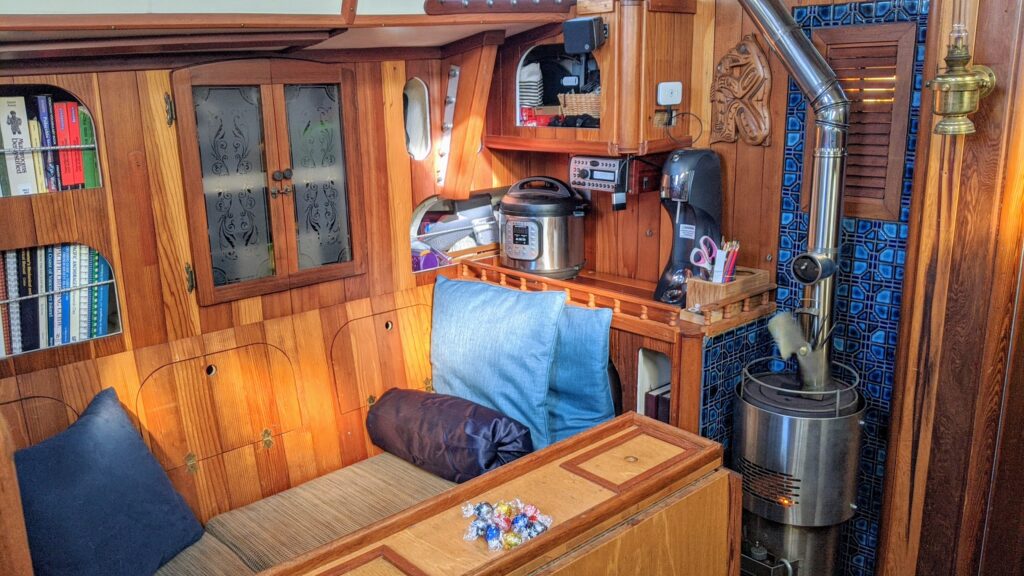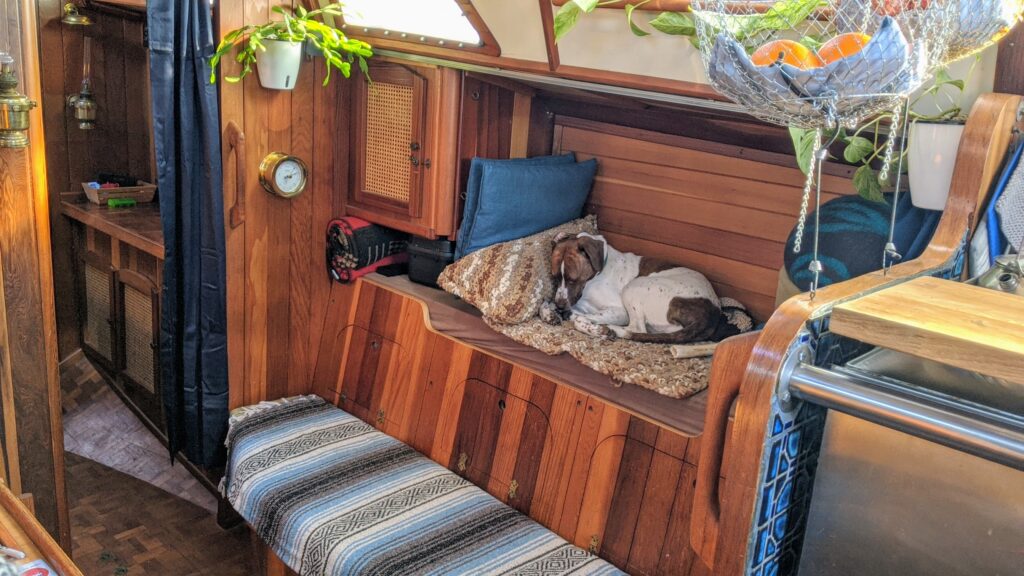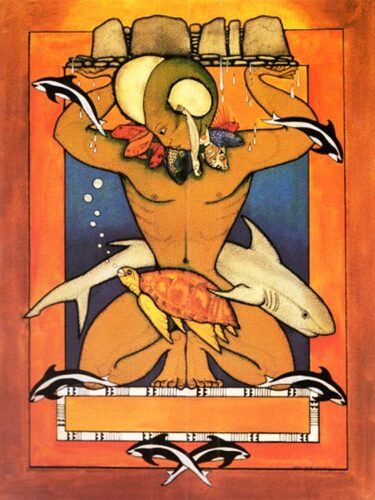
Sailing vessel Rua Hatu, a Vancouver 36 (hull #8 of 13) was designed by Bob Harris, built by Hidden Harbor Yachts of Sarasota, Florida, and finished by her original owner in Eureka, California.
Boat Specs
| Model | Vancouver 36 |
| Make | Hidden Harbor Yachts, Sarasota, Florida, USA |
| Year Built | 1981 |
| Hull Number | HHW360080581 |
| USCG No. | 641098 |
| MMSI | 366927960 |
| FCC Call Sign | WDK9241 |
| Height Length Breadth Depth | 56 ft (16.8 m) 36 ft (11 m) 11 ft (3.4 m) 5 ft (1.5 m) |
| Net tonnage Gross tonnage Displacement | 10 metric tons 13 metric tons 18500 lbs (8391 kg) |
| Keel type Ballast Rudder Rig Type Sailplan Engine Prop Rotation Fuel | modified long keel 8000 lbs (3639 kg) keel mounted Bermuda rig Cutter rigged sloop Westerbeke 44B4 (44hp) left handed (counter clockwise forward) Diesel 80 gallons (300 liters) |

Cabin
The interior was finished by the previous owner using Redwood in Eureka, California. The kitchen is equipped with a custom fridge/freezer powered by a freezer plate. The sink has hot water which is heated either by the engine, where the water circulates around coils to heat up, or using the AC water heater when we are attached to shore power in a marina. There is a propane stove with three burners and a bottom-heated oven.
The bathroom has a Dometic vacuum toilet and a sink/shower faucet that allows us to shower in the bathroom over the teak floor grate. There is a pump to empty the dedicated shower bilge through the sink through-hull to avoid soapy shower water mixing with the potentially oily bilge water.
The cabin can be heated using the built-in diesel heater. Diesel heaters are a unique experience and require attention to avoid dousing the cabin in toxic diesel smoke. Fortunately we are planning to stay in warm water and won’t be needing it too often.





Electronics
To sail comfortably it takes lots of electronics and tools. Here’s what we’ve got on board:
| Solar chargers | Victron MPPT 100/20 (Aft panels 2x 150W) |
| Victron MPPT 100/30 (dodger & side panels 4x 100W) | |
| Battery sensor | Victron Smart Battery Sense |
| Battery monitor | Victron BMV 712Smart |
| Batteries | House bank: 4x Northstar SMS AGM 220 Engine bank: 1x Northstar AGM 27 |
| Chartplotter | Raymarine Axiom 7 MFD |
| Radar | Raymarine Quantum 2 Doppler Radar |
| Autopilot | Raymarine ST4000+ Autopilot (Tiller) |
| Speed & Depth | Airmar DST 810 |
| Wind | Airmar 120WX Ultrasonic Windsensor |
| AIS | Raymarine AIS700 SOTDMA Transceiver |
| VHF Radio | Raymarine Ray90 VHF |
| Watermaker/Desalinator | Village Marine Tec LWM 120 (6gal/hour) |

Auxiliary Power
When the wind isn’t blowing, we get around thanks to a Westerbeke 44B Four naturally-aspirated diesel engine. From what I’ve heard, the original 39 HP Volvo was underpowered for the sheer size of this vessel and could only make about 4.5 knots under power. Thus we’re quite happy with the extra horsepower offered by the bright red Westerbeke we now have onboard. Even with all the extra horsepower, this engine sips fuel between 2,000 and 2,500 RPM (more than enough to get us where we are going) though it’s rated for cruising at 3,000 RPM.
Our 2 fuel tanks carry 80 gallons of diesel; 40 of which are situated midship in an aluminum tank, with another 40 situated under the bed in a HDPE tank. We also have a ~5 gallon day tank with a lift pump that gravity-feeds fuel to our Dickinson Antarctic heater, situated midship just aft of the mast.

The name
You have probably wondered where the name “Rua Hatu” comes from. We did, too, since we bought the boat already named.

THE OLDEST GREAT TAHITIAN MARAES AND THE LAST ONE BUILT IN TAHITI.
By Miss Teuira Henry
The oldest Tahitian maraes [communal or sacred place] on record are:—Tahu’ea (Magical-deliverance), in Ra’iatea; Mata’i-rea (Breeze-of-space), in Huahine; Po’ura-(Night-of-ura-birds), in Mai’ao (Sir Charles Sanders’ Island); Te-ahuru-a-tama (The-tens-of-children), Nu’u-rua (Double-fleet), Te-pua-tea (White-flower), Mata’i-re’a (Breeze-of-plenty), and Ahu-‘are (Wall-by-the-water), in Mo’orea; Maha’i-atea (Extensive-mitigation), in Tahiti-nui; and Mata-hihae (Eyes-flashing-with-rage), in Tahiti-iti or Tai’orapu.
Following is the story of their origin:—
Shortly after the waters of the deluge had subsided, the surviving people very busily set to work repairing their maraes, which had been broken down by the sea, and in making new ones; and there went forth Rua-Hatu-Tinirau (Source-of-fruitful-myriards), the Tahitian Neptune, from his cave in the reef at Raivavae, it is said, to visit his dominions. He swam first to Ra’iatea, where they had built a new marae, named Táhu’ea (Magical-deliverence), and dedicated it to him; so on it he placed as guardian ‘Oà-hi-vara (Blackness-fishing-in-mud), also called Hae-i-te-‘oà (Fierceness-of-blackness), god of quagmire. This strange being, it was said, was sometimes seen, by those who watched for him in the stillness of the night, to rise up from haunted waters in a swamp in the form of man, and shoot up into the air and then sink down into the mud again. Rua-hatu then swam to Huahine-nui and opened two passages in the reef, named Apo’o-uhu (Aperture-of-the-parrot-fish) and Peihi (Prayer-for-fishing). There he stood upon the point named Manunu (Benumbed), and placed the corner-stones of the marae called Mata’i-rea (Breeze-of-space), which he dedicated to the god Tane (god of beauty). He swam to Huahine-iti and only epened a passage in the reef there, called Fare-re’a (House-of-plenty).
He swam to Mai’ao-iti (Sir George Sanders’ Island), opened the passage called Ava-rei (Passage-with-a-neck), placed the corner-stones of the marae called Po-‘ura (Night-of-ura-birds), and dedicated it to the god Ta’aroa, which in Tahiti was regarded as the supreme god of Tahitian Pantheon. He swam to Afareaitu in the south of Mo’orea, opened the passage called Ti’a-‘ou’a (Stand-to-leap), placed the corner-stones of the marae named Te-ahuru-a-tama (The-tens-of-children), and nominated himself god there. He swam to Haapiti in the west of Mo’orea, opened the passage called Ta’o-te-ha (Say-the-healing-prayer), at the corner-stones of the marae named Nu’u-rua (double-fleet), and he was god himself there. Onwards he swam to Papeto’ai in the north-west, opened the passage called Faauru-po (Night-piloting), set the corner-stones of the maraes named Te-pua-tea (The-white-flower), Mata’i-re’a (Breeze-of-plenty), and Ahu’are (Wall-by-the-waves), upon all of which were enshrined the god Tane. Rua-hatu then swam to Tahiti and landed in the south, at Papara, opened the passage Fa’are’are’a (Make-joyful), set the corner-stones of the marae named Maha’i-atea (Extensive-mitigation), which was dedicated to Ta’aroa.
Finally, he swam round to the bluffs at Te-Ahu-upo’o in Tai’ara-pu, and landed amid the breakers. Then he set the corner-stones of the marae named Mata-hihae (Eyes-flashing-with-rage), and Tama-‘ehu (Fair-child, god-of-fire), was enshrined there.
TE-PUA-TEA, AFTERWARDS TAPTAPU-ATEA.
The marae named Te-pua-tea in Papetoai, Mo’orea, was later named Taputapu-atea (Sacrifices-from-abroad) after the great marae at Opoa in Ra’iatea, owing to a marriage of a chief of Papetoai to a chiefess of Opoa; and although only scattered stones now lie upon the site where it stood, yet their kneeling stone has been held sacred by their descendants, and it stands firmly planted in the ground near the road that leads to the pretty little octagon stone church of historic record, close by the marae grounds. It is named Turaa-ma-rafea (kneeling-stone-of-two-meeting) in commemoration of the union of the two parties. (Mr. S. Percy Smith mentions this stone in his book entitled “Hawaiki.”)
MAHA’I-ATEA IN PAPARA.
The marae, Maha’i-atea, has the following mythical history, which preserved it from the destroying hands of Pomare’s Christian zealots before mentioned in the paper on “More on the Ari’is of Tahiti,” published in the Journal of the Polynesian Society:
When Ruahatu swam to Tahiti, he arrived one morning early at Papara, and was met by some people who asked him who he was, and he replied, “E atua vau i te maha’i tua mea (I am a god of extensive mitigation),” and hence the name Mahai-tua-mea applied to the point where he stood and to the marae upon it. In commemoration of this legend the name was also adopted by the chief of Ra’ivavae. This marae, of a pyramidal form, measured two hundred and seventy feet in length, and ninety-four feet in breadth at its base; and one hundred and eighty feet long and seven feet wide at the top. It had ten grand steps quite round it, the first six feet high, and the others five, all of which were made of nicely squared coral rock about eighteen inches square, closely set together in rows, upon which were placed to advantage, other rows of round pebble stones about eighteen inches in circumference.
It stood grandly facing the sea, a becoming link between the ancient and modern history of Tahiti, until early in the sixties of last century, when William Stewart, a planter, who had purchased the little district of Atimaono, close to Papara, for a cotton and coffee plantation, influenced the French Governor, De le Ronciere, to force the people of Papara to let him have the stones for a bridge, which was built across Taharu’u in Papara. But a heavy freshet in the rainy season soon broke away the structure, and no stones remained in their places to tell the story. But even after the destruction of the steps, there remained the massive bulk of the marae, which nature had clothed in verdure like the “the everlasting hills,” still a valuable monument of the past, until the year 1910, when some more Europeans broke up its oval form, by making lime out of its coral rock, for a second and so far successful attempt at making a bridge to resist the rapid waters of Taharu’u.
TO’O-A-RA’I, THE LAST GREAT MARAE IN TAHITI.
The last great marae built in Tahiti was To’o-a-ra’i (Drawer-of-the-sky), erected near Maha’i-atea, after Pomare I. had subjucated all Tahiti and Mo’orea. It was the combined work of able-bodied men chosen from all the districts and from his subjects at the Paumotu Islands, also aided by Raiatean relatives and friends of Pomare’s, and every man furnished a stone for the work. All the usual ceremonies were performed in building the marae, and after giving it its name and the time for its consecration arrived, they found that no god had been chosen for it! A Raiatean chief, named Fa’anounou, and his people proposed to have Oro there, but the Tahitians wished to retain the prestige of one of their own gods for it, and at last there arose a dispute among them, which became so heated that both parties turned away in anger and dispersed to their own respective homes, only a Raiatean chief named Ari’i-mana remaining with Pomare. The very sea rose high and swamped the Raiatean canoes on their way home, so that it was with much difficulty that they at last arrived at their destination.



